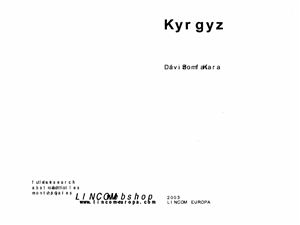Somfai Kara D. Kyrgyz. - Lincom Europa, 2003. - 65 p.
ISBN: 3895868434
Kyrgyz is a Turkic language, it is spoken by some 3,5 million people in Kyrgyzstan and its neighbouring countries (Uzbekistan, China, Tajikistan, Afghanistan, Kazakstan). It is spoken in the valleys and plateaus of the Tianshan and Pamir-Alai Mountain Ranges (e.g. Ch?i Valley, Talas Valley, Kara-Tegin). The Kyrgyz language belongs to the Kypchak group, although genetically related to South Siberian Turkic languages. During the Mongol Era, the Kyrgyz became the language of the nomad groups in the Chagatai Empire. It was strongly influenced by the Kazak and Uzbek languages. This present material of the Kyrgyz language is an up-to-date grammar based on the author’s five-year research with the Kyrgyz of Kyrgyzstan and Tajikistan (where the disappearing South dialect is still alive). In this book he tried to summarize up his observations, just as he did it in his first book about the Kazak language. There are useful information about the TAM (Tense-Mood-Aspect) categories of verb morphology, auxiliary verb formations and numerous examples to illustrate them. These aspects help to understand Kyrgyz literature and colloquial speech as well. The phono
ISBN: 3895868434
Kyrgyz is a Turkic language, it is spoken by some 3,5 million people in Kyrgyzstan and its neighbouring countries (Uzbekistan, China, Tajikistan, Afghanistan, Kazakstan). It is spoken in the valleys and plateaus of the Tianshan and Pamir-Alai Mountain Ranges (e.g. Ch?i Valley, Talas Valley, Kara-Tegin). The Kyrgyz language belongs to the Kypchak group, although genetically related to South Siberian Turkic languages. During the Mongol Era, the Kyrgyz became the language of the nomad groups in the Chagatai Empire. It was strongly influenced by the Kazak and Uzbek languages. This present material of the Kyrgyz language is an up-to-date grammar based on the author’s five-year research with the Kyrgyz of Kyrgyzstan and Tajikistan (where the disappearing South dialect is still alive). In this book he tried to summarize up his observations, just as he did it in his first book about the Kazak language. There are useful information about the TAM (Tense-Mood-Aspect) categories of verb morphology, auxiliary verb formations and numerous examples to illustrate them. These aspects help to understand Kyrgyz literature and colloquial speech as well. The phono

